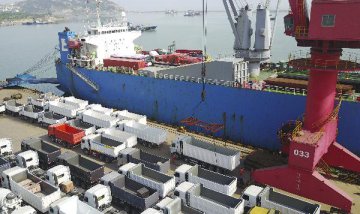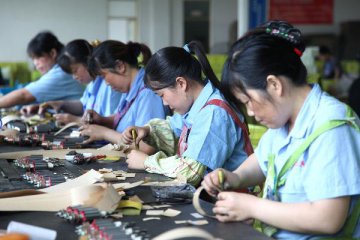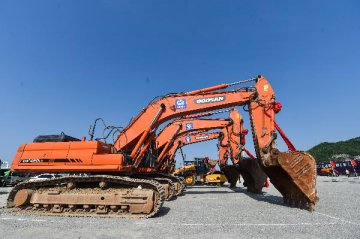
The economic data in April released by the National Bureau of Statistics (NBS) on May 15 dropped slightly. According to the data, China's value-added industrial output rose by 6.5 percent year on year in April, 1.1 percentage points slower than the growth in March. Index of services production surged by 8.1 percent year on year, 0.2 percentage point lower than that of last month. Total retail sales of consumer goods grew by 10.7 percent year on year to 2,727.8 billion yuan in April, 0.2 percentage point slower than the March level. In the first four months, the total investment in fixed assets (excluding rural households) was 14,432.7 billion yuan, a year-on-year growth of 8.9 percent, or 0.3 percentage point lower than that of the first three months.
Although growth in some economic indicators slowed down in April, China’s national economy continued to register a stable performance with good momentum for growth and the stable growth in major economic indicators didn’t change, according to NBS spokesperson Xing Zhihong. Relevant indicators in the first four months basically kept the stable growth in the first three months. For example, in January-April period, growth rate in value-added industrial output reached 6.7 percent, only 0.1 percentage point slower than it was in the first quarter. The total retail sales of consumer goods increased by 10.2 percent in the first four months, 0.2 percentage point higher than that in the first quarter. Therefore, the data change in April is expected in a reasonable range.
But Xing also indicated that there were new situations and new problems in economic operation. For instance, de-capacity faced great pressure as overcapacity in some industries was still very prominent. There’s no sufficient support for prices of crude material energy industry to continue to hike. In addition, development among regions was imbalanced. Value-added industrial output in Northeast China saw a growth of 1.6 percent. Besides, impetus for private investment needed to be strengthened further. Private investment surged by 6.9 percent during January and April, slower growth than that of investment in fixed assets. Therefore, more efforts should be made to put policy of supporting private investment into place and reform of streamlining administration and institute decentralization should be deepened.
Many experts predicted that private investment needs a period to recover and investment in infrastructure is still one of major drivers boosting China’s economic growth in 2017. Instead of declining, investment is expected to hike by about 10 percent this year, said Zhang Liqun, a researcher with the Development Research Center under the State Council, at 2017 China Auto Forum held on May 15. New urbanization and the Belt and Road Initiative will bring tremendous constructions of infrastructure and swap of local government bonds and promotion of public-private partnership (PPP) will improve fund guarantee. Therefore, investment in infrastructure will keep higher growth this year.
In the opinion of Lian Ping, chief economist with the Bank of Communications, it is difficult for infrastructure investment to maintain the high growth of the first quarter in the second quarter resulting from financing sources and cost increase. Lian indicated that the rapid growth in infrastructure investment in 2016 was mainly driven by the accelerating implementation of PPP projects. But it is exactly the slowdown in implementation of PPP projects and increase in financing cost that restrict the development of infrastructure investment in the future. The investment amount in PPP projects fell after reaching a peak in last January. But it usually takes 13 months from launch of PPP projects to implementation, which implies that investment amount of implementing PPP projects will begin to dive after the first quarter of this year.
Noticeably, auto retail sales rallied by 6.8 percent, down by 1.8 percentage points in April when compared with that in last month. This accorded with the data about decline in both auto production and auto sales, which was previously released by China Association of Automobile Manufactures (CAAM).
Dong Yang, standing vice-chairman of CAAM, indicated that there is still huge development potential in China’s automobile industry. 50 million units of cars are likely to be produced annually, nearly increase by 100 percent when compared with current production. Specifically, 40 million units of cars will be sold in domestic market and 10 million units overseas, up by above 20 million units than current sales. Dong remarked that although China’s automobile industry saw slow growth in the first four months of this year, it will climb at about 7 percent in the future, instead of 4 percent growth rate in 2015.
Translated by Vanessa Chen
























Latest comments